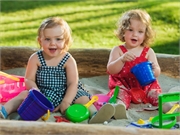Kids at 2 Utah Day Cares Easily Spread COVID to Families
By E.J. MundellHealthDay Reporter

FRIDAY, Sept. 11, 2020 (HealthDay News) -- It's not clear how COVID-19 outbreaks at three Salt Lake City child day care centers began, but a new report finds that 12 infected youngsters enrolled at two of the facilities easily passed SARS-CoV-2 to at least 12 family members.
In one case, an infected child with no symptoms of COVID-19 transmitted the illness to their mother, who became so sick she needed to be hospitalized.
The tale of these day care-linked clusters illustrate how efficient children are as vectors for COVID-19 infection -- and what steps can be taken to minimize the risk, experts say.
"While COVID-19 is typically less severe in children compared to adults, children can still play a role in transmission," noted emergency physician Dr. Robert Glatter, who wasn't involved in the new report.
"In fact, a previous study noted that children older than 10 can transmit the virus as efficiently as adults," said Glatter, who works at Lenox Hill Hospital in New York City. "Knowing this, it's vital to take proper precautions to reduce transmission, especially in child care settings."
The issue is of paramount importance as millions of kids warily return to school this fall.
The new study was led by Cuc Tran, of the U.S. Centers for Disease Control and Prevention's COVID-19 Response Team. Her group used detailed contact tracing to map out the genesis and spread of outbreaks of coronavirus infection at three separate Salt Lake City day care centers between April 1 and July 10.
Overall, a total of 12 children attending two of the facilities were known to be infected with the new coronavirus, the research found.
And those 12 kids were efficient at transmitting the virus to family back home: According to the study, "transmission likely occurred from children with confirmed COVID-19 in a child care facility to 25% of their non-facility contacts."
As is typical among children, all of the 12 infected children had either no or very mild symptoms. But infection was passed to 12 people in the home setting nonetheless -- among those cases, six mothers became infected as did three siblings, the CDC team said. One mom ended up requiring hospital care for COVID-19.
The exact origin of the outbreaks is unclear, but numerous staff members at the three day cares were found to be infected as well. "Staff members at two of the facilities had a household contact with confirmed or probable COVID-19," the researchers noted, but these employees "went to work while their household contact was symptomatic."
That's a red flag for any child care institution, including schools, Glatter said.
"This highlights the importance that staff members and [facility] attendees quarantine and get tested if their household members are symptomatic," he said.
And there are other ways that day care centers and other facilities can cut the risk. In accordance with CDC guidelines, "one vital aspect of this approach includes all children over the age of 2 wearing masks," Glatter said.
The CDC "also recommends the use of face masks, particularly among staff members, especially when children are too young to wear masks," Tran and her colleagues added. Frequent hand-washing, as well as "frequent cleaning and disinfecting of high-touch surfaces" is also recommended, the study group said.
As for kids who are back at school, the Salt Lake City findings show that "reliance on good public health measures is vital to preventing this type of spread and keeping children socially distant from vulnerable family members while in schools," according to Dr. Eric Cioe-Pena.
"That won't prevent school-based spread, but it will help mitigate the effects," said Cioe-Pena, who directs global health at Northwell Health in New Hyde Park, N.Y.
The findings were published Sept. 11 in the CDC's journal Morbidity and Mortality Weekly Report.
More information
The U.S. Centers for Disease Control and Prevention has more on the new coronavirus.

The news stories provided in Health News and our Health-E News Newsletter are a service of the nationally syndicated HealthDay® news and information company. Stories refer to national trends and breaking health news, and are not necessarily indicative of or always supported by our facility and providers. This information is provided for informational and educational purposes only, and is not intended to be a substitute for medical advice, diagnosis, or treatment.

